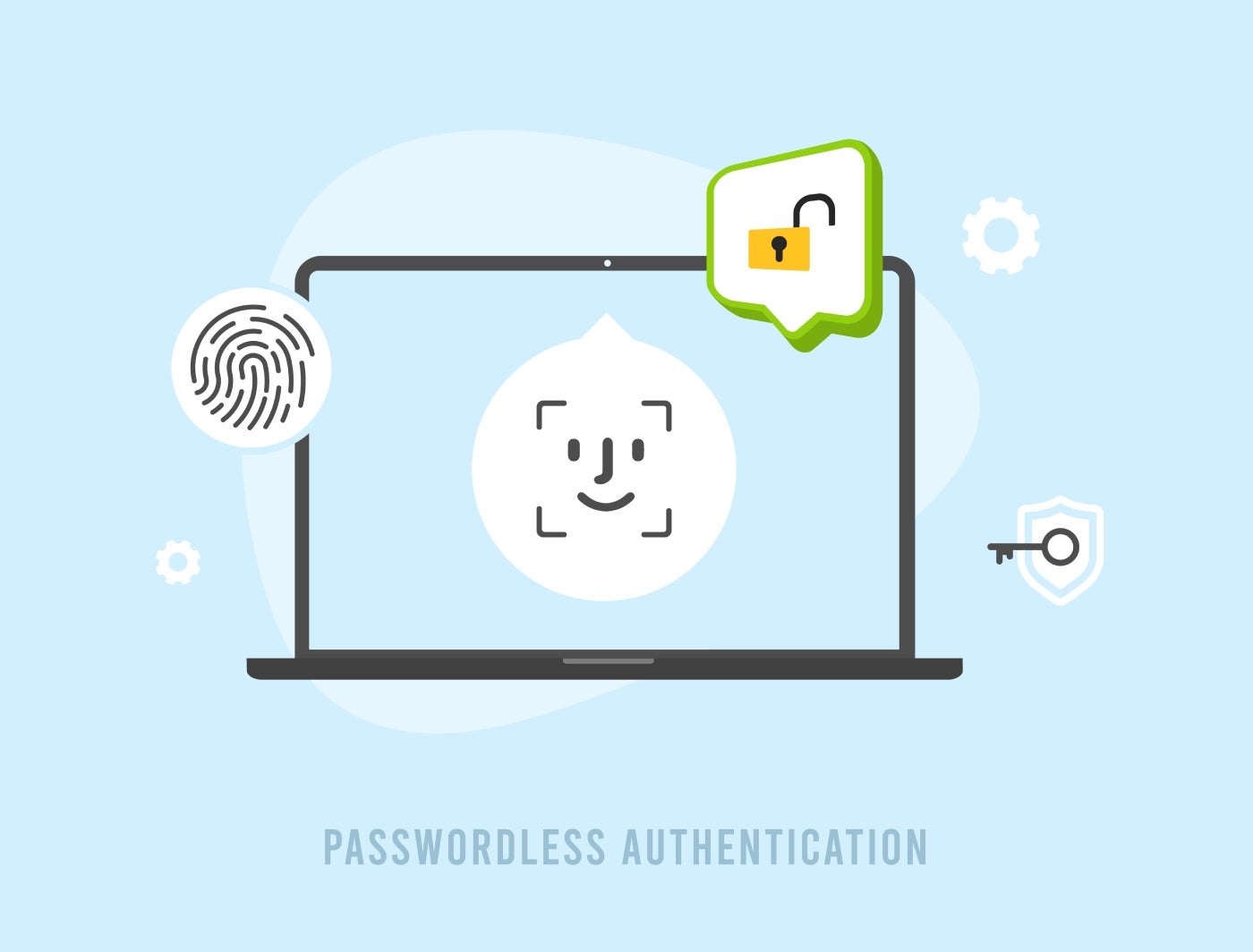
Passwordless authentication is a more secure method of granting access to systems. Typically, it works by verifying something unique to a user or something physical that the individual must possess.
In this article, we explore the types of passwordless authentication, benefits and limitations, and popular solutions.
| Benefits of passwordless authentication | Drawbacks of passwordless authentication |
|---|---|
| More secure than password-based systems. | May require more upfront training. |
| Smoother user experience (UX). | Higher short-term implementation costs. |
| Reduced need to reset user logins. | More difficult to resolve login issues. |
Passwordless authentication allows users to access a system without the need to provide a password. Instead, users are authenticated based on other factors, such as biometrics, magic links, hardware tokens, and more.
Businesses can reap many benefits from this. It’s a more secure way of authenticating users, making companies less susceptible to data breaches. Information technology (IT) departments can also spend less time supporting users with resetting passwords, and individual users can have a better experience gaining access to systems.
Types of passwordless authentication methods
With passwordless authentication, users typically can be verified with something that is either unique to them or something physical that only they would have. Below are several examples of how passwordless authentication can be implemented to improve both local and cloud security.
- Magic links: This is often a one-time use link that is sent to a user’s authenticated email or phone. Clicking the link will subsequently give the user access to the application.
- Biometrics: This works by verifying something unique to the user. Common examples include fingerprints, voiceprints, and facial scans.
- Hardware tokens: This can include USB devices, such as FIDO security keys, phones, smart cards, and near-field communication (NFC) devices.
- One-time passwords (OTP): OTP’s are codes that can be sent to a user’s verified email or phone and typically are only valid for a short period of time.
- Push notifications: Users logged in to an account or system on a separate device can receive a notification to authorize a new login.
Passwordless authentication benefits vs. passwordless authentication drawbacks
Although more secure, passwordless authentication comes at the cost of more difficult reset processes should users get locked out. Despite that, it’s becoming increasingly popular with as many as 41% of companies planning to adopt or continue using passwordless authentication over the next one to three years.
Benefits of passwordless authentication
- More secure than password-based systems: Since something unique to the user’s identity or a physical token is required, it’s more secure than password-based systems. Passwords, by comparison, are more susceptible to things like phishing, keylogging, and brute force attacks.
- Smoother UX: Eliminating the need to remember passwords makes it easier and faster for users to get access to systems. It can also be used in conjunction with single sign-on (SSO) so that a single set of credentials can be used to access multiple services.
- Reduced need to reset user logins: Many passwordless authentication methods, such as those that use biometrics and hardware tokens, don’t require the user to remember anything. As a result, it can significantly reduce the need to reset an account due to a forgotten password.
Drawbacks of passwordless authentication
Although it has many benefits, businesses should also examine the downsides of switching to passwordless authentication systems. Companies should consider the lifecycle of such a switch, such as the initial implementation to any ongoing items required to maintain the system.
- May require more upfront training: Users may be less familiar with a passwordless system, something that may require more initial training time and support for it to be used seamlessly.
- Higher short-term implementation costs: Businesses may incur higher short-term hardware and software costs to implement a new system.
- More difficult to resolve login issues: The task of resetting a password is simple for a company’s IT department. Meanwhile, Passwordless systems can be more challenging and costly if a user gets locked out of their account as it could require replacement hardware tokens or an alternate method to regain account access.
Factors impacting passwordless authentication security
Businesses can reap many benefits from a passwordless authentication system. While the adoption rate continues to grow over time, some businesses may struggle with its implementation for the following reasons.
- Costs to obtain the new system: Although companies can save money over the long term, the initial upfront cost may impact a company’s cash flow negatively.
- Time needed to switch: Switching systems can disrupt existing workflows and companies may be hesitant to make changes that may interrupt daily business activities.
- Training resources required: Depending on the complexity, training may be required for the IT team and other employees to use and troubleshoot the new system properly.
Popular passwordless authentication solutions
There are many providers of passwordless authentication solutions, and the best one for a business will depend on its unique circumstances. Some solutions like ManageEngine’s ADSelfServicePlus product can provide one-click access to a wide range of applications while others, such as OneLogin, can evaluate the context and risk of each login before granting access.
Prove Auth
Used by large companies worldwide, Prove Auth provides passwordless and OTP-less authentication for mobile, web, and omnichannel experiences by using app push notifications and biometrics. Businesses must speak with the sales team to get pricing information.
Thales SafeNet Trusted Access
Businesses can combine multi-factor authentication (MFA) and SSO capabilities while easily managing user access to a wide range of platforms. Adaptive, push, and pattern-based authentication can be done, and pricing is customized based on each individual company.
ManageEngine ADSelfServicePlus
This allows businesses to simplify logins by enabling SSO one-click access to cloud and on-premises applications. Pricing is free for small companies with up to 50 users, and larger businesses can request a custom quote.
OneLogin
Ideal for startups to medium-sized companies, OneLogin can evaluate the details of logins, such as device type, time of day, and location. It also offers other features, such as SSO and MFA. Bundled pricing begins at $4 per user each month, depending on what features are selected.
Factors that influence passwordless authentication solution pricing
Pricing for a passwordless authentication solution typically is driven by specific features and functionality provided. Other factors that can impact pricing include the number of users, subscription method and length, and whether the product has any physical hardware requirements.
Should your organization use a passwordless authentication solution?
Passwordless authentication provides businesses with a more secure way of ensuring authorized access to systems. While there may be short-term expenses associated with making the switch, this can prevent the costs that could be incurred as the result of a data breach, each of which is estimated to cost $4 million on average.









